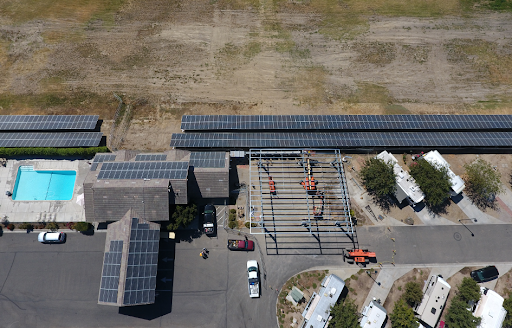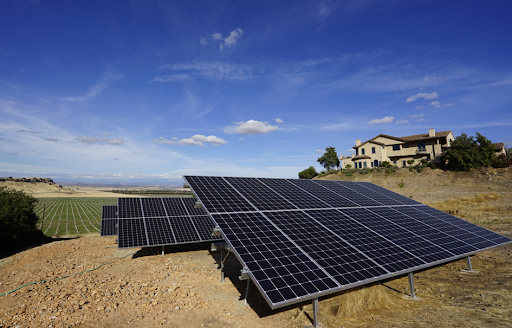Stone Foundations For Solar Arrays: Cost, Pros & Cons
Key Takeaways
- Stone foundations are durable and can last for centuries.
- Initial costs can be high due to material and labor expenses, but long-term maintenance is generally low.
- Stone foundations are environmentally friendly as they use natural materials that blend seamlessly with the surroundings.
- They are suitable for stable soil conditions and can face challenges in areas with loose or shifting ground.
- Nuance Energy’s Osprey PowerRack™ uses earth anchor foundation which is faster and more cost-effective than stone foundation.
Types Of Stone Foundation For Solar Arrays
- Gravel Ballast Foundation: Often used in areas where excavation is not feasible or undesirable. Solar panels are mounted on a racking system that is held in place by heavy gravel or concrete blocks.
- Concrete Pier Foundation: Provides strong and long-lasting support in areas with high wind loads or poor soil. However, the installation can be more labor-intensive and expensive compared to other foundation methods.
- Precast Concrete Block Foundation: A more flexible and less labor-intensive alternative to poured concrete, these heavy blocks are placed on the ground surface – and commonly used in remote areas where it is difficult to transport concrete-mixing equipment.
- Stone Gabion Foundation: Wire baskets filled with stones are used as foundations in sloped or uneven terrain as they provide a stable base without extensive excavation.
| Nuance Energy is your superior solution for Ground Mount solar. Our patented foundation technology, in the Osprey PowerRack™, allows for rapid installation using only handheld tools, significantly reducing both time and costs compared to traditional racking systems. This cutting-edge technology works for residential and commercial installations, and Nuance Energy empowers solar installers to take back control of their installation schedules, control project COGS, gain market share, increase the speed of installation, and reduce costs and labor. In contrast, a traditional ground mount is much more unpredictable, slower, and costly.
Find out how Nuance Energy can accelerate your solar projects with the Osprey PowerRack™ line, and boost your profitability. Contact us today to discuss our innovative ground-mount solutions. |
Costs Of Stone Foundation
The cost of stone foundations can vary widely based on several factors such as the type of stone used, the complexity of the design, excavation requirements, and regional labor costs.
On average, stone foundations cost between $12 and $35 per square foot. This includes material and labor costs.
For example:
- For 800 square feet, the cost can range from $9,600 to $28,000.
- For 1,200 square feet, it ranges between $14,400 and $42,000.
- For 1,600 square feet, it could cost between $19,200 and $56,000.
These costs account for the traditional use of stacked stone or engineered stone materials, which are both labor-intensive and require skilled masons. Stone foundations can also incur additional charges for excavation, waterproofing, and drainage systems for long-term durability.
* The pricing was estimated at the time of this writing and is subject to change in the future.
Pros Of Stone Foundation
- Stability and Durability: Stone foundations have good stability, which makes them suitable for various soil conditions. They can withstand environmental stresses such as wind and erosion.
- Minimal Ground Disturbance: Some stone foundation types, like ballast foundations, do not require extensive earth excavation.
- Quick Installation: Stone foundations, particularly precast options, can be installed rapidly – which can reduce labor costs and project timelines.
- Cost-Effectiveness: While initial material costs may vary, the overall savings in labor and time during installation can make stone foundations a cost-effective choice in the long run.
Cons Of Stone Foundation
- Thermal Conductivity: Stone foundations have low thermal resistance, which can lead to heat loss in colder climates unless properly insulated.
- Limited Flexibility: Once installed, stone foundations are less adaptable than other types, such as steel or concrete structures that can be modified or expanded more easily.
- Potential for Soil Compaction: The weight of stone ballasts can lead to soil compaction, which may negatively affect plant growth in agrivoltaic systems where crops are grown alongside solar panels.
- Higher Upfront Costs: Depending on the type of stone foundation used, initial material costs can be higher compared to other foundation types like steel or simple concrete options.
Use Cases Of Stone Foundation

Stone foundation can be used even in contaminated land.
- Landfills and Contaminated Sites: Stone foundations, particularly ballast systems, are used on landfills or contaminated soils as there’s no need to excavate and penetrate potentially hazardous layers like clay or HDPE liners.
- Areas with Poor Soil Conditions: In regions where soil quality is poor, such as soft or unstable ground, stone foundations can stabilize solar arrays without extensive excavation.
- Urban Environments: In urban settings where space is limited and existing structures must be preserved, stone ballast foundations allow for quick installation. Solar arrays can be easily integrated into rooftops or other surfaces without compromising structural integrity.
- Agricultural Applications (Agrivoltaics): Stone foundations can support solar panels while allowing agricultural activities to continue.
- Aesthetic Integration: In projects where aesthetics are important, such as residential installations or building-integrated photovoltaics (BIPV), stone veneers can be used alongside traditional solar modules.
Why Earth Anchor Foundation By Nuance Energy Is Better Than Stone Foundation

Nuance Energy’s earth anchor foundation is faster to install and more cost-effective than stone foundation.
At Nuance Energy, we have developed a better alternative to traditional stone foundations: our patented earth anchor foundation. Here’s why it’s the superior solution:
1. Cost Efficiency
Our Osprey PowerRack™, which uses the earth anchor foundation, can be installed with handheld tools – significantly reducing installation costs. There’s no need for expensive heavy machinery and labor-intensive processes associated with stone foundations, such as excavation and concrete work.
2. Quick Installation
A fully trained crew can install the Osprey PowerRack™, including foundations, racking, and modules, in just 16 days for a 2MW project. In contrast, traditional stone foundations often require extensive preparation and longer installation times, usually exceeding 60 days.
3. No Geotechnical Reports Needed
Our system uses real-time soil condition anchor load testing, which means no costly geotechnical reports that are usually required for traditional foundations. This speeds up the installation process and further reduces costs.
4. Adaptability to Challenging Terrain
Our earth anchor foundation is designed to perform well in various soil conditions, including hard or rocky ground, where traditional stone foundations might struggle.
Frequently Asked Questions (FAQs)
Are stone foundations suitable for all climates?
Stone foundations are generally suitable for a wide range of climates, but in extremely wet or unstable soil conditions additional measures may be necessary for stability.
How do stone foundations compare with concrete?
Stone foundations are more eco-friendly and can blend seamlessly with the surroundings. While concrete is quick to install and provides strong support, it has a higher carbon footprint due to cement production.
What is the lifespan of a stone foundation in solar arrays?
A well-constructed stone foundation can last for centuries.
Can stone foundations be used for large-scale solar farms?
Yes, stone foundations can be used for large-scale solar farms, especially in areas where local materials are readily available.
What types of projects can benefit from Nuance Energy’s solutions?
- Agricultural Solar: Helping farmers maximize land use while reducing energy costs.
- Commercial Installations: Scalable solutions that can accommodate large-scale energy needs without heavy equipment.
- Disaster Recovery: Modular systems that can be easily transported and installed in emergency situations.
- Landfills and Brownfields: Transforming contaminated land into productive solar power sites while maintaining soil integrity.
Save Time & Money on Your Next Solar Project
Request a QuoteRECENT POSTS
- DPW Solar vs Nuance Energy Mounted Solar Options: Cost & Benefits
- Geotechnical Report Cost & Requirements For Solar Projects
- Are Solar Panels Worth It In Nevada? Costs & Options
- OSPREY PowerRack Ground Mount System Compatibility: Single- and Dual-Axis Trackers
- Rammed Earth Foundation For Solar Arrays: Cost, Pros & Cons
- Agrivoltaics Explained: Solar & Agriculture Combined
- Large Scale Solar Systems Options: Pros & Cons
- Best Solar Options For Farms & Agriculture: Cost, Pros & Cons
- Unirac vs MT Solar Mounted Options: Cost & Benefits
- IronRidge vs Grengy Mounted Solar Options: Cost & Benefits

